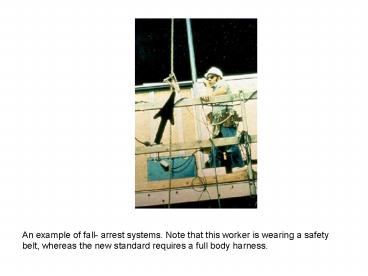An example of fall- arrest systems. Note that this worker is wearing a safety belt, whereas the new standard requires a full body harness. - PowerPoint PPT Presentation
1 / 25
Title:
An example of fall- arrest systems. Note that this worker is wearing a safety belt, whereas the new standard requires a full body harness.
Description:
Slide 4 Boating Safety Train Safety Slide 7 The imaginary company depicted in the picture above is doing some redecorating in their reception area. – PowerPoint PPT presentation
Number of Views:285
Avg rating:3.0/5.0
Title: An example of fall- arrest systems. Note that this worker is wearing a safety belt, whereas the new standard requires a full body harness.
1
An example of fall- arrest systems. Note that
this worker is wearing a safety belt, whereas the
new standard requires a full body harness.
2
Obvious violation No guardrail and no
fall-arrest system. Also, because scaffold is six
tiers high, it must be tied in to the building.
1926.451(c)(1)
3
Scaffold has X-brace that can act as a top rail,
but a midrail and toe boards are still required.
Also, these workers are not wearing fall
protection, and there is a mortarboard on the
cantilevered platform, in violation of
1926.452(c)(5)(iii).
4
(No Transcript)
5
Boating Safety
6
Train Safety
7
Crane Safety?
8
The imaginary company depicted in the picture
above is doing some redecorating in their
reception area. Theyre also about to celebrate
an employees birthday theyd better hope an
Occupational Safety and Health Administration
(OSHA) inspector doesnt crash the party. How
many OSHA violations can you spot?
9
- This picture represents an OSHA violation.
First, the metal conduit box is not designed as a
portable outlet box at the end of an extension
cord. The box should be mounted permanently on a
wall. Also, note the exposed wires (not
insulated) at the end of the box. could result
in an electrocution hazard or an electrical fault
which could ultimately lead to a fire of nearby
combustible materials.
10
Scaffolding Safety?
11
(No Transcript)
12
(No Transcript)
13
(No Transcript)
14
(No Transcript)
15
(No Transcript)
16
(No Transcript)
17
(No Transcript)
18
Respiratory Protection?
19
Ladder Safety?
20
(No Transcript)
21
Fall Protection?
22
(No Transcript)
23
Electrical Safety?
24
(No Transcript)
25
Vehicle Safety?































